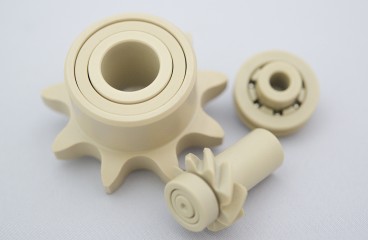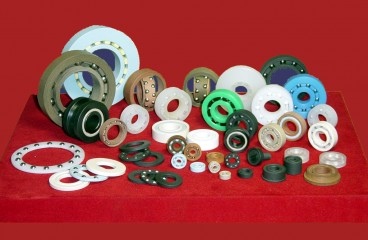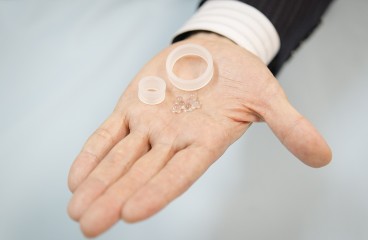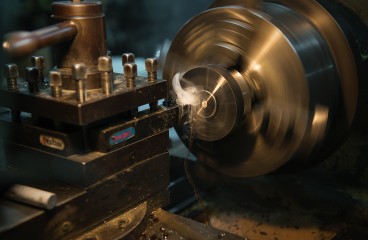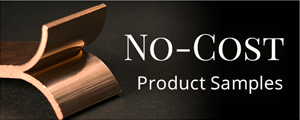Manufacture and sales plastic processed products
Kashima Bearings Corporation View Company Info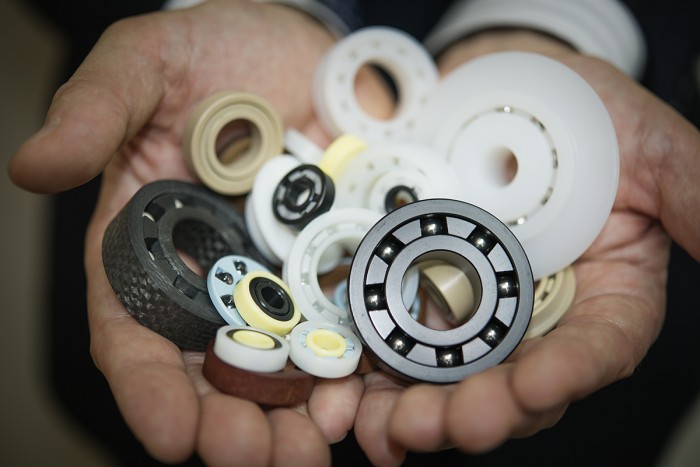 Plactic Ball Bearings
Plactic Ball Bearings
Almost 30 years ago, Kashima Bearings Corporation began manufacturing their plastic ball bearings. When the founder Shizuo Kashima visited his wife’s hometown, someone at the fishing port complained to him that the conveyor belt that carries fish would always get rusty. So, he suggested using parts made of plastic resin that is resistant to alkaline from fish and corrosion by salt water. And then, he designed his own plastic ball bearing and started manufacturing it.
You may not know that Leonardo da Vinci drew the world’s first sketches of wooden bearing in the 15th century, or that 100 years later, Galileo Galilei described the basics of the ball bearing that is used in Today’s modern technology. The history of the mechanical element, bearing, is of great antiquity. Ever since the Industrial Revolution, bearings have always been a vital element in a mechanism, which is why some in Japan have called it the “Rice of the Industry.” An industrial pillar that supports the foundation of society, it has been refined and improved upon over many years, while being used in various forms of machinery, from the industrial machinery of the manufacturing process, to the actual products themselves.
Japan is known globally as a leading force in the world of bearing technology, and there is a long-established Japanese company that manufactures a special kind of bearing. Although bearings are often metallic, Kashima Bearings Corporation manufactures and sells an original brand of plastic bearings. Their plastic ball bearings (PBB) are used in various machinery and medical devices, as well as special environments where metal cannot be used.
Plastic Bearings: Water-Resistant, Chemical-Resistant, and Heat-Resistant
Almost 30 years ago, Kashima Bearings Corporation began manufacturing their plastic ball bearings. When the founder Shizuo Kashima visited his wife’s hometown, someone at the fishing port complained to him that the conveyor belt that carries fish would always get rusty. So, he suggested using parts made of plastic resin that is resistant to alkaline from fish and corrosion by salt water. And then, he designed his own plastic ball bearing and started manufacturing it.
Today, their bearings are used not only in fishing port equipment, but also in the field of food processing, electronic components, semiconductor manufacturing, and medical equipment. Because resin is self-lubricating, plastic bearings do not need oil/grease, something metallic bearings need. Furthermore, depending on the resin, some are resistant to chemical and/or heat. The company offers the widest selection of plastic bearings to satisfy the clients’ needs in any applications.
A good example of an application that PBB is suitable for, is a washer or a sterilizer. Because these would require bearings to be water-resistant, chemical-resistant and heat-resistant, a normal metallic bearing would not be ideal. Recently, medical devices have increasingly become advanced, and MRI (Magnetic Resonance Imaging), for example, cannot have material that becomes magnetized. Since resin is basically non-magnetic, PBB is perfect for such equipment.
The diverse materials used and its special qualities give PBB a wide variety of applications, which makes it the ideal solution for many of their client’s requests.
A Wide Array of Products Backed by a Vast Collection of Scientific Data
Kashima Bearings Corporation have been in the plastic processing business for 60 years, and their leading product is the plastic ball bearing, but when they first developed their staple product, it did not receive much attention. In 1993, Yuji Kashima, the head of Sales at the time (who became President in 1996), and Hiroyuki Azuma (current Vice President) devised a strategy and came to the conclusion that they should “become a niche company that specializes in something specific,” and they decided to fully focus on developing their PBB line of product. At the time, PBB was not yet well-known even in Japan, and as a product that was ahead of its time, it did not sell well.
It remained that way for a decade, until finally things changed for the better, marking a major turning point for the company. They were looking for a university research team to join forces for product development, when they met Katsuyuki Kida at Osaka University. Prof. Kida is an important figure in the field of fracture mechanics, receiving “The Best Paper Prize” from UK journal Fatigue & Fracture of Engineering Materials & Structures in 2005. Working with him, they were able to make giant leaps in research and development, which lead to them accumulating a vast archive of digital data. Through joint development, they have been able to calculate the ideal surface roughness of ball bearings from rotation rate and feed rate, find the perfect combination of race/ball/retainer, reduce friction, and effectively create grooves with longer lifespans. They are also conducting experiments on the durability of bearings underwater.
With their unrivaled amount of scientific date, they are able to develop and release products that are unmatched. Kashima says, “Including our research underwater, I believe we have the most comprehensive set of date on bearing, not only in Japan, but in the whole world. Using the data, we can give the client a pretty good estimation of the lifespan of a PBB.” In 2009, they were selected by Ministry of Economy, Trade and Industry for the “Strategic Foundational Technology Improvement Support Operation,” which focuses on novelty, potential and influence of a certain technology and supports the development process. They are still working together with Prof. Kida (who now belongs to Toyama University), collecting even more data.
In addition to the vast data they boast, they offer a wide selection of products, and if all possible combinations were counted, the number comes out to be somewhere around 60,000. Furthermore, they manufacture the actuator along with the bearing as a whole unit, so they are able to customize and manufacture according to the clients’ requirements.
For Kashima’s Plastic Bearings, Going Global is the Aim
Instead of mass-production, at Kashima Bearing Corporation, they design the bearings so they can be made for small orders. The plastic ball bearing crafted with the know-how and processing technology gained from years of experience in the business has a great reputation and has been praised by customers for its durability and high precision.
The company also showcases their products at domestic and foreign conventions often, spreading the word about PBB. President Kashima says, “We offer a variety of solutions from our wide selections based on data accumulated from our research. Recently, interest in oil/grease free PBB has been increasing from the medical community for hygienic reasons. We have been trying to raise awareness of our product overseas in the medical device field but unfortunately it still is relatively unknown. But in the mechanical industry, I believe people face the same problems both here and abroad, so I’d like people from other countries to find out about our solutions to their problems through exhibitions, and hopefully expand PBB globally.”
Besides aiming globally, he has another goal. Currently, metallic bearings adhere to ISO, JIS and Germany’s DIN standards, but a niche mechanical element like PBB does not have a set standard yet. With the unparalleled amount of scientific data on plastic bearings at hand, the company plans on working with Prof. Kida to set a new standard for plastic ball bearings in the future, which they hope would become the global standard.
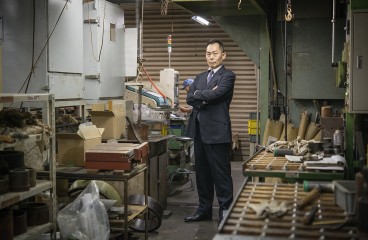
Kashima Bearings Corporation
Business Description: Manufacture and sales plastic processed products
Headquarters Address: 2-9-21 Himesato, Nishiyodogawa-ward, Osaka, 555-0025 Japan
Representative Director: Yuji Kashima
Founded: 1961
Website: www.kashima-kagaku.com


